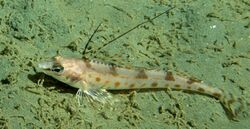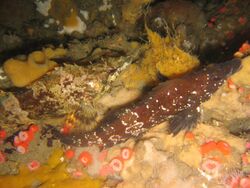Biology:Zaniolepididae
| Zaniolepididae | |
|---|---|

| |
| Long-spined combfish (Zaniolepis latipinnis) | |

| |
| Two painted greenlings (Oxylebius pictus) | |
| Scientific classification | |
| Domain: | Eukaryota |
| Kingdom: | Animalia |
| Phylum: | Chordata |
| Class: | Actinopterygii |
| Order: | Scorpaeniformes |
| Suborder: | Cottoidei |
| Superfamily: | Zaniolepidoidea |
| Family: | Zaniolepididae Jordan & Gilbert 1883[1] |
| Subfamilies | |
|
See text | |
The Zaniolepididae is a family of marine ray-finned fishes classified within the suborder Cottoidei of the order Scorpaeniformes. They are found in the North Pacific Ocean.
Taxonomy
Zaniolepididae was first proposed as a family in 1883 by the American ichthyologists David Starr Jordan and Charles Henry Gilbert.[1] this taxon has been classified as the subfamily Zaniolepinae within the Hexagrammidae.[2] This family is classified within its own superfamily, the Zaniolepidoidea, within the suborder Cottoidei of the Scorpaeniformes.[3] Other workers have found that if the Scorpaeniformes, as delimited in Fishes of the World, is not included in the Perciformes it renders the Perciformes paraphyletic. These workers retain the Cottoidei as a suborder within the Perciformes while reclassifying Zaniolepidoidea as the infraorder Zaniolepidoales.[4]
Subfamilies and genera
Zaniolepididae has 2 genera classified within it, each within its own monotypic subfamily:[3][5][1]
- Subfamily Oxylebiinae Gill, 1862
- Oxylebius Gill, 1862 (painted greenlet)
- Subfamily Zaniolepidinae Jordan & Gilbert 1883
- Zaniolepis Gilbert, 1858 (combfishes)
Characteristics
Zaniolepididae is characterised by having an incision between the first and second dorsal fins and by having an anal fin with 3 or 4 spines. The caudal fin may be rounded or truncate, there is one complete lateral line and the scales are ctenoid.[3] These are medium sized fishes with maximum total lengths of 25 to 30 cm (9.8 to 11.8 in).[5]
Distribution
Zaniolepidiae are endemic to the eastern North Pacific Ocean from Alaska south to Baja California.[2]
Utilization
Zaniolepididae has one species, Zaniolepis frenata, which has been recorded as a source of food for the Native American inhabitants of San Nicolas Island off the coast of Southern California during the Middle Holocene.[6]
References
- ↑ 1.0 1.1 1.2 Richard van der Laan; William N. Eschmeyer; Ronald Fricke (2014). "Family-group names of Recent fishes". Zootaxa 3882 (2): 001–230. doi:10.11646/zootaxa.3882.1.1. PMID 25543675. https://www.researchgate.net/publication/268078514.
- ↑ 2.0 2.1 Catherine W. Mecklenburg; William N. Eschmeyer (2003). "Family Hexagrammidae Gill 1889 Greenlings". California Academy of Sciences Annotated Checklists of Fishes 2. https://www.calacademy.org/sites/default/files/assets/docs/hexagrammidae.pdf.
- ↑ 3.0 3.1 3.2 J. S. Nelson; T. C. Grande; M. V. H. Wilson (2016). Fishes of the World (5th ed.). Wiley. pp. 467–495. ISBN 978-1-118-34233-6. https://sites.google.com/site/fotw5th/.
- ↑ Ricardo Betancur-R; Edward O. Wiley; Gloria Arratia et al. (2017). "Phylogenetic classification of bony fishes". BMC Evolutionary Biology 17 (162): 162. doi:10.1186/s12862-017-0958-3. PMID 28683774.
- ↑ 5.0 5.1 Froese, Rainer, and Daniel Pauly, eds. (2022). "Zaniolepididae" in FishBase. August 2022 version.
- ↑ Vellanoweth, R. L.; Erlandson, J. M. (1999). "Middle Holocene Fishing and Maritime Adaptations at CA-SNI-161, San Nicolas Island, California". Journal of California and Great Basin Anthropology 21 (2): 257–274. http://escholarship.org/uc/item/6r29b87h.pdf.
Wikidata ☰ Q26897763 entry
 |

